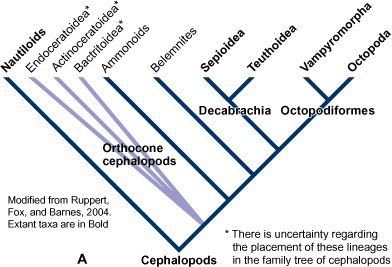Classification
The name Sepia apama is split into two parts. The first, Sepia, is the Latinized form of the Ancient Greek word σηπία, which means cuttlefish (sepia, 2013). The second part, apama, was the name of Apama I, the wife of the first ruler of the Seleucid Empire in 324 BC (Apama, 2013).
Domain- Eukarya
The Australian Giant Cuttlefish is defined as Eukarya because
of its complex cells, organelles bound by membranes, and a nucleus
witha a specific genetic code.
Kingdom- Animalia
The Kingdom Animalia includes all organisms that have no
alternation of generation, are mobile at some point in their
lifecycle, and are multicellular. This Kingdom include organisms
like the
Blue Whale, the
Mantis
Shrimp,
Peregrine Falcons,
American Crocodiles, and the
Fossa.
Phylum- Mollusca
To be a part of the Phylum Mollusca, an organism must have a
mantle that secretes a plate or shell and also have two pairs of
main nerve cords.

Source: University of
California Museum of Paleontology
Figure 1. Phylogenetic tree for the Phylum Mollusca based on
morphological characteristics.
Class- Cephalopoda
Cephalopoda includes all organisms that have bilateral
symmetry as well as a set of arms or tentacles. It includes
animals like the
Coconut Octopus,
the
Humboldt Squid, nautilus and
the
Common Cuttlefish.

Source: University
of California Museum of Paleontology
Figure 2. Phylogentic tree for the Class Cephalopoda.
The Order Sepiida is part of Sepioidea in the tree.
Order- Sepiida
Sepiida is the oder for only one type of organism, the
cuttlefish. It includes all 100+ species.
Family- Sepiidae
Genus- Sepia
Species- Sepia apama
(Encyclopedia of Life, 2013)
Next, check out where they live!
Source: Thierry Rakotoarivelo